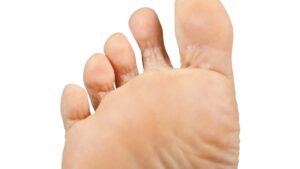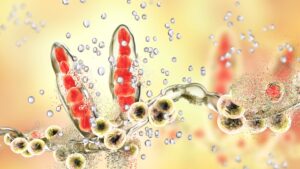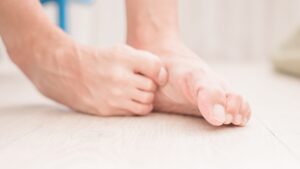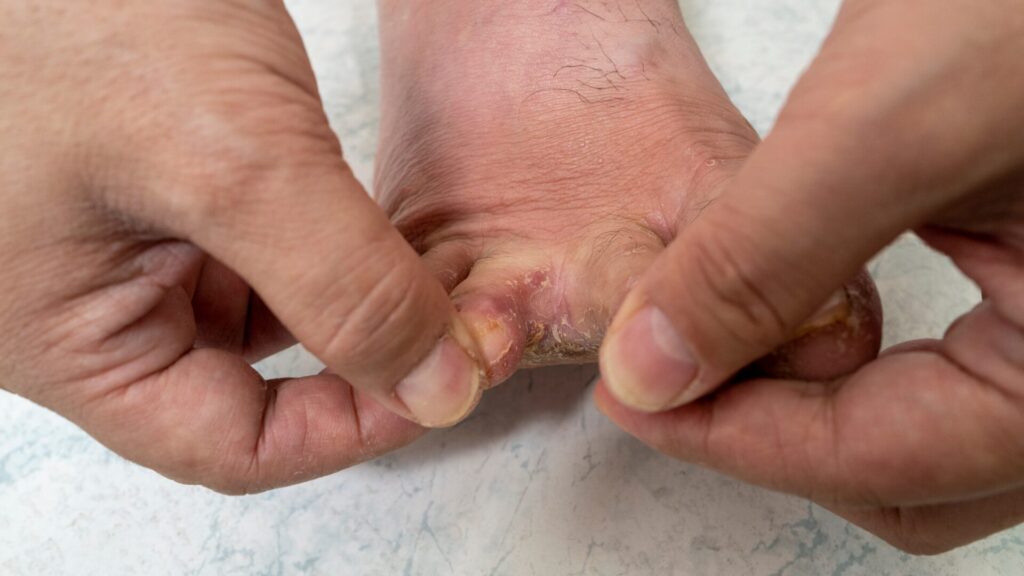A fungal infection of the foot called tinea pedis, or athlete’s foot, affects the skin of the foot. It is a condition that can cause a great deal of discomfort, including itching, burning, and cracking of the skin. Choosing the right tinea pedis medication is crucial in effectively managing and overcoming this condition. In this guide, we will explore various aspects of Tinea Pedis, including its symptoms, diagnosis, and the range of medications available for its treatment. Our aim is to provide a comprehensive understanding of how to tackle this common but bothersome ailment, emphasizing the importance of selecting the appropriate medication for effective relief and recovery.
Table of Contents
Toggle- Understanding Tinea Pedis
- The Importance of Proper Diagnosis
- A Deep Dive into Tinea Pedis Medications
- How to Use Tinea Pedis Medication Effectively
- Side Effects and Considerations
- Preventing Tinea Pedis: Beyond Medication
- The Role of Diet and Nutrition in Managing Tinea Pedis
- Frequently Asked Questions (FAQs)
- Conclusion
Understanding Tinea Pedis

What is Tinea Pedis?
A fungal infection called tinea pedis mainly affects the skin on the feet. The area between the toes is a typical spot for infection due to the thriving nature of this ailment, commonly known as Athlete’s Foot, which prefers warm, wet surroundings.
It’s caused by dermatophytes, a type of fungi that can also affect other parts of the body, leading to various types of tinea infections.
Symptoms to Watch For
Recognizing the symptoms of Tinea Pedis is the first step toward seeking effective treatment. Common indicators include:
- Itching and Burning Sensations: The affected areas often feel itchy and may burn, particularly after removing shoes and socks.
- Cracked Skin: The skin may crack, peel, or flake, especially between the toes.
- Redness and Inflammation: Affected areas may swell and turn red.
- Blisters: In severe cases, blisters may form, leading to pain and potential secondary bacterial infections.
Identifying these symptoms early can lead to a quicker diagnosis and treatment plan, including the selection of the right tinea pedis medication.
The Importance of Proper Diagnosis
Seeking a professional diagnosis is critical in ensuring that you receive the correct tinea pedis medication and advice for your condition. Athlete’s Foot can sometimes be confused with other skin disorders, such as eczema or psoriasis, which require different treatments. Here’s why seeing a healthcare professional is crucial:
- Accurate Identification: A healthcare provider can accurately diagnose Tinea Pedis by examining the affected area. Sometimes, a skin scraping may be analyzed under a microscope to detect the presence of fungi.
- Tailored Treatment Plans: Based on the severity and type of fungal infection, a professional can recommend the most effective treatment plan, which may include prescription-strength tinea pedis medication.
Overview of Diagnostic Methods for Tinea Pedis
The following diagnostic methods are commonly used to confirm a case of Tinea Pedis:
- Physical Examination: The first step is a visual inspection of the affected areas, looking for typical symptoms of Athlete’s Foot.
- Skin Scraping and Microscopy: A simple test where a small sample of skin is taken and examined under a microscope to detect fungus.
- Culture Test: In some cases, a culture test may be performed to identify the specific type of fungus, helping to tailor the treatment effectively.
Understanding the importance of proper diagnosis is crucial in the fight against Tinea Pedis, as it ensures the use of the correct tinea pedis medication and increases the chances of a full recovery.
A Deep Dive into Tinea Pedis Medications

Topical Antifungals: The First Line of Defense
Topical antifungals are often the initial treatment for Tinea Pedis, applied directly to the affected area. They function by either eradicating the fungus or stopping its growth. Commonly used topical tinea pedis medication includes:
- Clotrimazole: Effective for various fungal infections.
- Terbinafine: Provides quick relief from itching and burning.
- Miconazole: Targets the fungus and reduces inflammation.
- Tolnaftate: Known for its ability to prevent fungal growth.
These medications are available in various forms, such as creams, sprays, powders, and gels, allowing for flexible application methods tailored to the user’s preference and the infection’s location.
Oral Medications: When Topicals Aren’t Enough
Oral antifungal drugs may be recommended in more severe situations or in the event that topical therapies are ineffective. These systemic treatments are more powerful and can treat the infection from within. Common oral tinea pedis medication includes:
- Fluconazole: Taken once a week or as prescribed by a healthcare provider.
- Itraconazole: Effective for people with a compromised immune system.
- Terbinafine: Often recommended for severe or persistent infections.
Over-the-Counter vs. Prescription Medications
Understanding the difference between over-the-counter (OTC) and prescription tinea pedis medication is key to choosing the right treatment:
- OTC Medications: These are accessible without a prescription and can be effective for mild to moderate infections. They include topical antifungals like clotrimazole and terbinafine.
- Prescription Medications: For more severe cases, prescription-strength medications, both topical and oral, may be necessary. These offer a more potent treatment option and are tailored to the individual’s specific condition by a healthcare professional.
Choosing the right tinea pedis medication requires understanding the severity of the infection and, in some cases, a professional diagnosis.
How to Use Tinea Pedis Medication Effectively
Successfully treating Tinea Pedis involves more than just choosing the right medication; it requires proper application and adherence to a treatment regimen. Here’s a step-by-step guide on how to effectively use tinea pedis medication:
Applying Topical Medications
- Clean and Dry: Before applying medication, wash and thoroughly dry your feet, especially between the toes.
- Apply as Directed: Use the medication exactly as prescribed by your healthcare provider. Cover the affected area completely, and apply a little beyond to ensure all the fungus is treated.
- Consistency is Key: Apply the medication at the same times each day to maintain effective levels of the medication on the skin.
- Complete the Course: Continue using the medication for the full duration prescribed, even if symptoms improve earlier, to prevent recurrence.
Best Practices for Taking Oral Antifungals
- Follow Your Prescription: Take oral tinea pedis medication exactly as directed by your healthcare provider.
- Monitor for Side Effects: Be aware of potential side effects, such as digestive issues or liver function changes, and report any concerns to your doctor.
- Avoid Alcohol: Some oral antifungals can interact with alcohol, so it’s best to avoid it during your treatment period.
Tips on Ensuring the Effectiveness of the Treatment
- Maintain Foot Hygiene: Preserve proper foot hygiene by keeping your feet dry and clean.
- Use Separate Towels: Avoid spreading the fungus by using a separate towel for your feet.
- Disinfect Shoes: Regularly disinfect your shoes to kill any lingering fungus.
By following these guidelines, you can maximize the effectiveness of your tinea pedis medication and speed up the recovery process. Remember, patience and diligence are key to successfully treating Tinea Pedis.
Side Effects and Considerations
The fungal infection can be well treated with tinea pedis medicine, but it’s important to be informed of any possible side effects and other factors to take into account. Understanding these can help in managing them effectively and deciding when it might be necessary to consult a healthcare professional.
Common Side Effects of Topical Antifungals
- Skin Irritation: Burning, itching, or redness where the application was made.
- Dry Skin: Some formulations may dry out the skin, requiring the use of a moisturizer.
- Allergic Reactions: Rare, but may include rash, itching, or swelling, especially if you have a history of allergic reactions.
Potential Side Effects of Oral Antifungal Medications
- Digestive Issues: Nausea, diarrhea, and abdominal pain can occur but are generally mild.
- Liver Function: Due to the potential side effects of certain oral antifungals, routine blood tests are required to evaluate liver health while on therapy.
- Skin Rash: An uncommon but possible side effect that should be reported to a healthcare provider.
When to Seek Medical Advice for Side Effects

- Severe Reactions: If your severe skin reactions or symptoms are not relieved by over-the-counter drugs.
- Liver Concerns: If you experience any of the following symptoms, you should see a doctor right away: yellowing of the skin or eyes, black urine, or extreme exhaustion.
- Allergic Symptoms: Any signs of an allergic reaction, such as difficulty breathing, swelling of the face, lips, tongue, or throat, should be treated as an emergency.
Using tinea pedis medication safely and effectively means paying attention to how your body responds to the treatment. Always discuss any concerns or side effects with your healthcare provider to ensure the best care for your Tinea Pedis.
Preventing Tinea Pedis: Beyond Medication
Successfully treating Tinea Pedis with tinea pedis medication is a significant achievement, but preventing its recurrence is equally important. Incorporating lifestyle changes and home remedies can greatly reduce the risk of future infections. Here’s how you can keep your feet healthy and free from Athlete’s Foot:
Lifestyle and Home Remedies
- Keep Your Feet Dry: Fungi thrive in damp environments.
- Use Antifungal Powders: Sprinkle antifungal powder on your feet and in your shoes daily.
- Change Socks Regularly: Wear moisture-wicking socks and change them if they get wet or sweaty.
- Breathable Footwear: Select shoes with materials that let your feet breathe if you want them to be breathable.
- Protect Your Feet in Public Areas: Wear flip-flops or sandals in public restrooms, showers, and areas with pools to protect your feet.
Preventive Measures
- Regular Foot Inspections: Check your feet daily for signs of infection, especially if you’ve had Tinea Pedis before.
- Disinfect Footwear: Treat shoes with antifungal sprays or powders regularly.
- Avoid Sharing Personal Items: Never share towels, shoes, or socks with others to prevent the spread of fungus.
Implementing these practices can significantly diminish the chances of developing Tinea Pedis. While tinea pedis medication effectively treats the infection, prevention focuses on minimizing the risk factors associated with fungal growth.
The Role of Diet and Nutrition in Managing Tinea Pedis
Diet and nutrition play a crucial role in the management and prevention of Tinea Pedis. A healthy diet can boost your immune system, making your body more efficient at fighting off infections, including fungal ones like Athlete’s Foot. Here’s how specific dietary choices can impact your susceptibility to and ability to recover from Tinea Pedis:
Foods to Include
- Probiotics: Yogurt, kefir, and other fermented foods can enhance gut health, which in turn supports the immune system.
- Garlic: Known for its antifungal properties, incorporating garlic into your diet may help combat fungal infections.
- Foods Rich in Zinc: Seafood, beef, and pumpkin seeds, rich in zinc, can improve immune function.
- Antioxidant-Rich Foods: Fruits and vegetables high in antioxidants can help protect your cells and support overall health.
Foods to Avoid
- Excess Sugar: Consuming too much sugar might encourage the growth of fungus and worsen diseases. Limiting sugar can reduce the risk of prolonged fungal growth.
- Refined Carbohydrates: Similar to sugars, refined carbs can increase fungal growth. Opt for whole grains instead.
- Alcohol: Alcohol can impair your immune system and should be consumed in moderation, especially if you’re prone to fungal infections.
While no diet can cure tinea pedis medication, making smart nutritional choices can support your body’s defenses against fungal infections and enhance the effectiveness of medical treatments.
Frequently Asked Questions (FAQs)
How long does it take for Tinea Pedis medication to work?
The effectiveness and speed of tinea pedis medication can vary depending on the severity of the infection and the type of medication used. Topical antifungals usually show improvement within a week, while oral medications might take a bit longer to fully resolve the infection. Consistent application as directed is crucial for success.
Can Tinea Pedis recur after treatment?
Yes, Tinea Pedis can recur. Recurrence can be minimized by adhering to preventive measures, such as maintaining foot hygiene, using antifungal powders, and wearing breathable footwear.
Are there any alternative treatments for Tinea Pedis?
Apart from conventional tinea pedis medication, some individuals explore natural remedies, such as tea tree oil or vinegar soaks, as complementary treatments. However, it’s important to discuss these options with a healthcare provider before starting them to ensure they are safe and potentially effective.
Is it possible to prevent Tinea Pedis entirely?
While it may not be possible to prevent Tinea Pedis entirely, the risk can be significantly reduced through good foot hygiene, proper footwear, and avoiding wet, communal areas without foot protection.
What should I do if over-the-counter medications don’t work?
If over-the-counter tinea pedis medication does not resolve the infection, it’s essential to consult a healthcare professional for a proper diagnosis and possibly stronger prescription medication.
Conclusion

Choosing the right tinea pedis medication and following through with the prescribed treatment plan are essential steps in effectively managing and overcoming Tinea Pedis (Athlete’s Foot). This guide has covered the importance of recognizing symptoms early, seeking a professional diagnosis, understanding the range of medications available, and the significance of proper application and adherence to treatment.
Preventive measures, including maintaining good foot hygiene, wearing appropriate footwear, and making dietary considerations, play a crucial role in avoiding recurrence. While tinea pedis medication is fundamental in treating the infection, incorporating these lifestyle adjustments can enhance treatment effectiveness and promote overall foot health.
For those facing persistent or recurrent Tinea Pedis, it’s important to consult with a healthcare professional for a tailored treatment approach. Remember, overcoming Tinea Pedis is not only about treating the current infection but also about preventing future occurrences through informed and proactive measures.
SEE ALSO:
- Understanding the 7 Levels of Lymph Nodes in the Neck: A Comprehensive Guide
- 7 Important Insights: Is Croup Contagious? Understand the Risks & Protections
- The L612 Pill (Loratadine 10 mg): Essential Insights for Effective Allergy Relief
- 5 Amazing Benefits of Digestive Enzyme Supplements for Optimal Health
